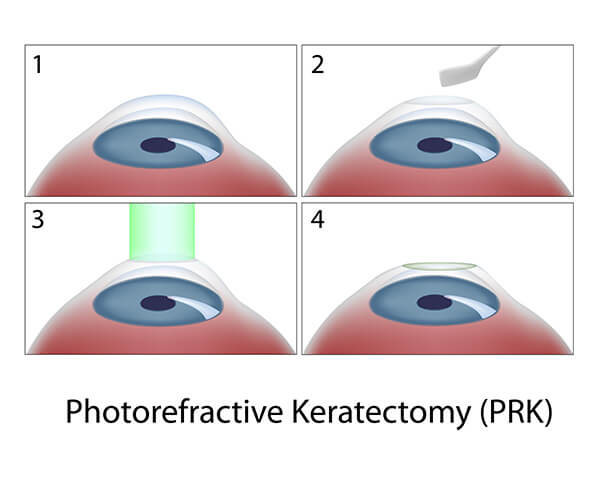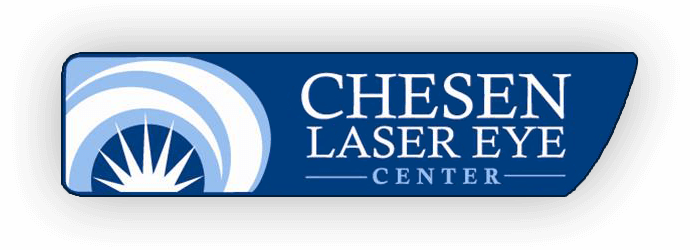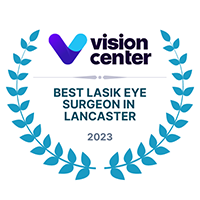Home » Services » LASIK Eye Surgery » LASIK Alternatives
LASIK Alternatives
PRK
PRK (photorefractive keratectomy) was at one time the most common laser eye surgery. It uses the same excimer laser as the LASIK procedure to reshape the outer layer of the cornea to correct for nearsightedness, farsightedness and astigmatism. Presently LASIK is more common but PRK is still an excellent alternative for patients who cannot undergo LASIK Surgery.
Reasons to consider PRK:
- Nearsightedness (myopia).
- Farsightedness (hyperopia).
- Astigmatism (irregularly shaped cornea).
- Cornea too thin for LASIK.
The Procedure
In preparation for surgery, anesthetic eye drops are administered. Next, a speculum is placed in the eye to keep the eyelids open which is normally not uncomfortable. While the patient fixes his or her gaze on a target, the laser reshapes the cornea by removing tissue (a process called ablation) which is controlled and closely monitored by Dr. Chesen. The laser is actually guided by a detailed map of the patient’s eye which has been programmed into a computer beforehand. The ablation usually takes less than a minute for each eye depending on how high the patient’s vision prescription is. Most patients feel no discomfort during the procedure. After the procedure is complete, a contact lens is placed on the eye. The patient may go home shortly after the procedure; however they may not drive themselves.
The Recovery
Dr. Chesen will prescribe medication and eyedrops for your recovery . He will also schedule several check-up appointments to monitor the healing process, followed by periodic visits over the next several months. Most patients can return to work in 2-4 days.
How PRK Works
The laser used in photorefractive keratectomy is called an excimer laser. It emits a specific wavelength of cold-ultraviolet light energy that vaporizes fractional layers of cells, leaving a very smooth surface.
By carefully sculpting the shape of the outer layer of the cornea, this laser — a “cool” laser that does not produce heat — creates an optimal surface layer for the eye’s lens. For nearsighted patients, the laser slightly flattens the top of the cornea. For farsighted people, PRK surgery yields a slightly steeper cornea. In patients with astigmatism, the laser smooths out irregularities. Dr. Chesen uses the newest and most state of the art equipment for the precise measurements and calculations to map your cornea and the desired correction.
PRK is preferred for patients who have thin corneas, as well as patients who have corneal irregularities. These conditions would complicate a LASIK procedure and make the patient a less than ideal candidate for LASIK. However, because PRK removes considerably less corneal tissue than LASIK procedures, it is possible to perform this procedure on patients who have issues such as a thin cornea. Other situations in which PRK is preferred include patients who have job or leisure activities which make them poor candidates for LASIK. This may include patients such as athletes where there is a high potential for damage to the flap during such activities. In these cases a procedure which does not require the creation of a flap, such as PRK, eliminates this concern.
Risks of PRK
Any surgery includes risks. PRK is considered a simpler procedure than LASIK because Dr. Chesen does not cut into the cornea, but works only on the surface. Many of the risks of PRK are the same as those for LASIK. Night glare is a fairly common side effect and will improve with time. When you reach your 40s, you may still need reading glasses for presbyopia.
Advantages of PRK Eye Surgery
The major advantage of PRK eye surgery is that it is a very uncomplicated procedure and does not require the creation of a flap. Another significant advantage to PRK eye surgery is it is available to many patients who are not ideal candidates for LASIK procedures. Patients who have thin corneas, as well as patients who have work or recreational activities which prevent them from having a procedure involving the cutting of a flap can both benefit from PRK eye surgery.
PRK vs LASIK
The visual outcome is the same. The difference is the first few days after the surgery. In LASIK the cornea is cut and a flap is created. In PRK a very thin layer of cells is removed from the surface of the cornea. The actual laser treatment that is applied to the cornea is the same. In LASIK the recovery is such that the patient can drive and work the day after surgery. In PRK there are several days of mild to moderate blurry vision. The ability to drive and work varies in these patients.
PRK Healing Time Explained
The PRK healing time is longer than the healing time required for LASIK and improved vision may not be evident for several days. Conversely, LASIK patients will experience improved vision the day after the procedure. The PRK healing process is considered to be slightly more uncomfortable than that of LASIK and may take longer.
Ideal Candidates for PRK Surgery
Dr. Chesen can advise a patient whether or not they are a good candidate for PRK surgery. Patients who are considering this procedure should visit the office for a complimentary screening in order to determine if they are an ideal candidate and if the procedure is likely to be successful. In general, good candidates for PRK surgery include those who have mild to moderate myopia or hyperopia, those who have career or leisure requirements which make having a flap impractical and patients who are not eligible for LASIK based on the shape or thickness of their cornea.
PRK and The Active Career and Lifestyle
Do you have a career that requires a lot of activity such as military, police officer, firefighter or other types of highly involved action based careers? Do you enjoy a very active lifestyle by doing things such as swimming, skydiving or scuba diving? Do you have to wear glasses in order to do those things? If so, PRK may be the laser surgery for you!
People with active lifestyles or careers are said to have been recommended to have PRK because you may be more vulnerable to eye injuries. With PRK there is no flap made during the procedure so there would be less of a chance of injury should something come into contact with the eye. Therefore, if you lead an active lifestyle or have a career that is demanding physically, then PRK may be for you.
Frequently Asked Questions
Chesen Laser Eye Center – The Visian ICL doctors of Pennsylvania
Dr. Chesen at Chesen Laser Eye Center is proud to offer an amazing new refractive lens implant called the Visian™ ICL. (also called the implantable contact lens) For patients who are looking for vision correction alternatives to LASIK, glasses or contact lenses the ICL lens has proven to be a viable alternative. The Visian™ ICL actually corrects up to -15 diopters of nearsightedness and extends well beyond the treatable limits of LASIK eye surgery. If you have been told that LASIK eye surgery is not an option please feel free to contact us immediately and we will be happy to provide a complimentary screening to determine your candidacy.
Unlike traditional contact lenses that go on the surface of the eye, Visian ICL is surgically inserted into the eye where it provides excellent quality of vision for a wide range of correction needs. Many patients often describe their vision after ICL surgery as crystal clear.
Determining Your Visian ICL candidacy
The only way to determine your candidacy for the Implantable Contact lens implant is to come in for a comprehensive eye examination with Dr. Chesen at Chesen Laser Eye Center. After a series of eye tests the doctor will be able to determine the best vision correction option for you. Choosing the Visian™ ICL as your refractive implant of choice needs to be a carefully thought out and researched decision. We make every effort to provide the best vision care solutions to our patients and that is why we have selected this revolutionary lens.
You might be a good candidate for the Visian™ ICL if
- You have thin corneas and LASIK eye surgery is not a safe option.
- You have dry eye syndrome (www.dry-eye-syndrome.net)
- You have extreme levels of myopia (nearsightedness)
- You are a nearsighted patient between the ages of 25 and 50.
Before determining your actual candidacy we suggest doing a significant amount of research on your unique visual situation. Make sure to interview qualified comprehensive eye surgeons, not just LASIK surgeons. You can rest assured that Dr. Chesen at Chesen Laser Eye Center will only provide the best possible vision correction options.
The Surgical Process – Visian ICL
Dr. Chesen welcomes you to his Visian ICL surgical center in Reading, Pennsylvania. Our staff and credible doctors offer a very sterile and accommodating environment for ICL surgery. After being escorted in the surgical suite and prepped for surgery your eye will be numbed with light topical anesthetic. This surgery process is very similar to the widely accepted phacoemulsification cataract surgery with which Dr. Chesen has 25 years of experience. Prior to the ICL surgery Dr. Chesen will make two microscopic holes in the iris. Once the eye is numbed the surgeon will make 2 side port incisions and one main temporal incision that is critical to the insertion process. Next Dr. Chesen will insert the ICL through the main temporal incision and place the lens behind the iris and in front of the crystalline lens. This insertion procedure is typically performed one eye at a time. There is very little discomfort and normally no pain associated with the procedure. Some drops or perhaps oral medication may be prescribed and a visit is usually scheduled the day after surgery. Patients will be advised to arrange for someone to drive them to and from surgery.
The Advantages of Visian ICL
1. Lens Implant of Versatility
Visian™ ICL is actually a removable lens implant and can correct a wider range of prescriptions than LASIK or PRK. Also, the ICL can be removed if needed.
2. Incision Size Advantages
If you are a highly nearsighted patient seeking a Visian ICL in Pennsylvania would you rather choose a lens with a 7mm incision size where you need eye stitches or one with a 3mm that requires no stitches. The ICL is implanted with a 3mm incision size instead of other phakic IOL alternatives. The incision required to implant the foldable Visian ICL is very small and done in a safe zone of the eye so as to not negatively impact vision.
3. Beyond the limits of lasers – A wide treatment range
The Visian ICL has proven to be the phakic IOL lens of choice for high myopes and patients with severe levels of nearsightedness. The Visian ICL can correct from -3.0 to -20.0 diopters with or without astigmatism and hyperopia.
4. Biocompatibility
The Visian ICL is made from Collamer, a collagen copolymer. Collagen is the same naturally occurring substance present in all of our connective tissue and the eye. It is highly biocompatible and not recognized as a foreign object as a result of its unique makeup. Implantation of the lens does not physically change any part of the cornea or other part of the eye, side effects such as halos and glare are almost nonexistent. Also, if needed or requested, the Visian ICL can be removed.









